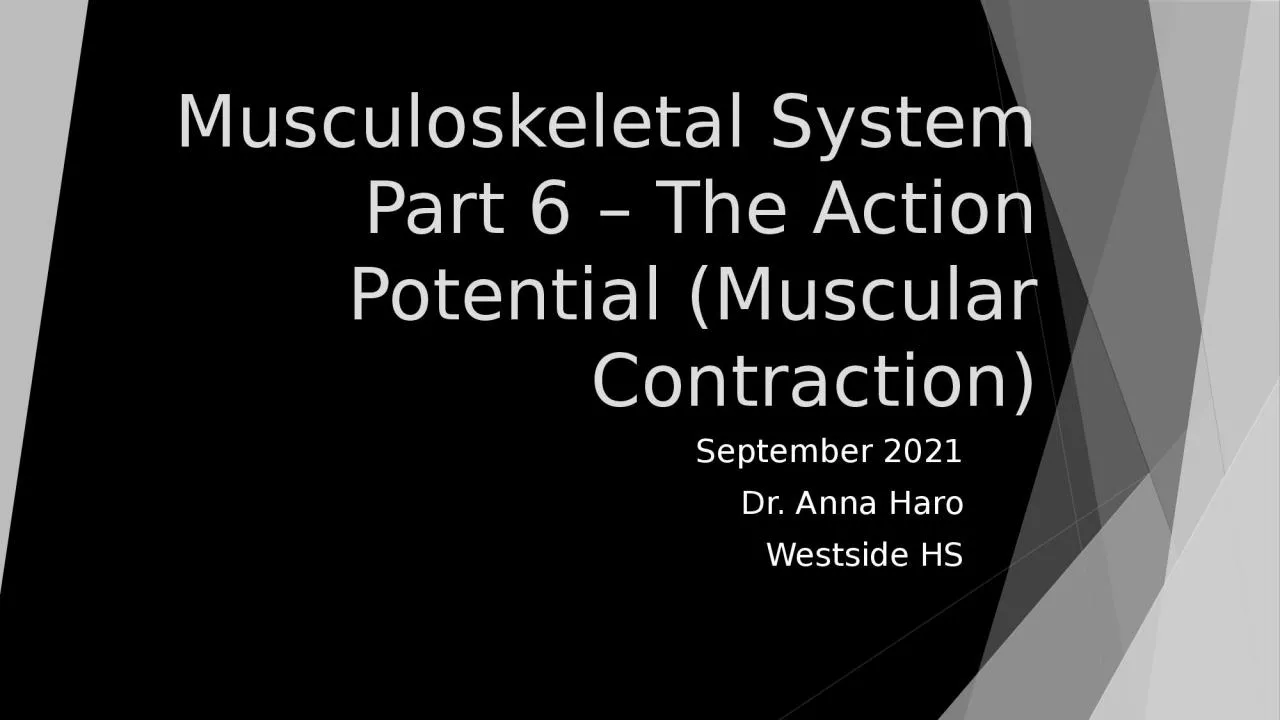

Muscular Contraction September 2021 Dr Anna Haro Westside HS LEARNING Objectives TEKS 130231 c 1A amp B and 130231 c 2A B C F amp G amp 3B Students will apply previous knowledge of human and cellular biology and chemistry ID: 931352
Download Presentation The PPT/PDF document "Musculoskeletal System Part 6 – The Ac..." is the property of its rightful owner. Permission is granted to download and print the materials on this web site for personal, non-commercial use only, and to display it on your personal computer provided you do not modify the materials and that you retain all copyright notices contained in the materials. By downloading content from our website, you accept the terms of this agreement.
Slide1
Musculoskeletal SystemPart 6 – The Action Potential (Muscular Contraction)
September 2021
Dr. Anna Haro
Westside HS
Slide2LEARNING Objectives TEKS:
§130.231.(
c)(1)(A, & B) and §130.231.(c)(2)(A, B, C, F, & G) & (3)(B)
Students will apply previous knowledge of human and cellular biology and chemistry.
Students will evaluate the relationship between the nervous system and the musculoskeletal system.
Students will describe the function of a motor neuron.
Students will identify the steps of an action potential.
Students will describe the four ions used in the generation of motor neuron stimulation.
Slide3Objetivos de aprendizaje
TEKS:
§130.231.(c)(1)(A, & B) and §130.231.(c)(2)(A, B, C, F, & G) & (3)(B)
Los estudiantes aplicarán conocimientos previos de biología y química humana y celular.
Los estudiantes evaluarán la relación entre el sistema nervioso y el sistema musculoesquelético.
Los estudiantes describirán la función de una neurona motora.Los estudiantes identificarán los pasos de un potencial de acción.Los estudiantes describirán los cuatro iones utilizados en la generación de estimulación de neuronas motoras.
.
Slide4What causes a muscle to contract?
“A muscle contraction
is triggered when an Action Potential travels along the nerves to the muscles. Muscle contraction begins when the nervous system generates a signal. The signal, an impulse called an action potential, travels through a type of nerve cell called a motor neuron.” (Visiblebody.com, 2021).
Slide5What is a motor neuron?
The motor neuron carries an electrical signal _______ from the spinal cord to the cell membrane of the muscle cell. One neuron can innervate multiple cells and muscle fibers, causing simultaneous contraction of the entire muscle.
Initially, the signal originates from a sensory neuron, which is transmitted to the brain, relayed by the thalamus, perceived by the cerebral cortex, and then transmitted back out to the muscle to stimulate a response, thus generating a muscular contraction.ACh is the NT responsible for the transmission of motor neuron signals.Image from:
https://alevelbiology.co.uk/notes/myelinated-motor-neurons/
, accessed 13 Sept 2021.
Slide6What is an action potential?
An
action potential is a rapid rise and subsequent fall in voltage (or electric charge) across a cellular membrane with a characteristic pattern to generate an electrical impulse and subsequent muscle contraction.The influx and efflux of ions creates a net positive or net negative charge between the inside and outside of the cell membrane. The difference in electrical charge during the action potential is called the potential difference and compares the relative charge inside the cell to outside the cell.
The change in the electric charge creates the impulse.
The motor neuron creates an electrical impulse, or
action potential, that causes the muscle to contract. Discuss: what types of muscle tissue receive transmission from the nervous system?
Slide7What are the basic steps of action potential?
Resting phase, also called the resting potential is when the neuron is at rest. There is no net movement of ions into or out of the cell. The membrane potential is negative (more positive cations outside the cell than inside the cell.)
The rising phase is when the influx of positive ions (mainly Na++) outpace the efflux of cations, resulting in a rapid shift from a negative charge to a positive charge.Threshold is the point at which the impulse is generated when the inside of the cell reaches its maximum positive charge, this causes
depolarization
, which leads to muscular contraction.
Repolarization occurs when the membrane potential shifts back to negative and returns to resting phase.
Slide8What ions create the concentration gradient for an action potential to occur?
Na
KCaClDiscuss: which are cations and which are anions?Active transport occurs through the Na/K ATP pump. Discuss: What is ATP?K influx and efflux occur naturally due to concentration gradient.
Ca stimulation of the pre-synaptic neuron causes the release of
ACh
.Rapid influx of Na due to stimulation from ACh creates depolarization and the electrical impulse for the action potential, causing the muscle to contract.
Slide9Questions about muscle contraction and the action potential?
I don’t have most of the answers, but I can help you find the right references.
Remember the HON-code? https://www.hon.ch/HONcode/
Slide10References
Shier D, Butler J, Lewis R. Hole’s Human Anatomy and Physiology, 9
th edition, McGraw Hill Education Publishing, 2002.http://ibbiologyhelp.com/HumanPhysiology/nervesandsynapses.html
https://www.visiblebody.com/learn/muscular/muscle-contractions